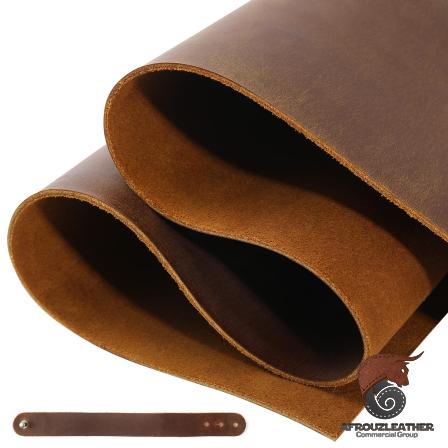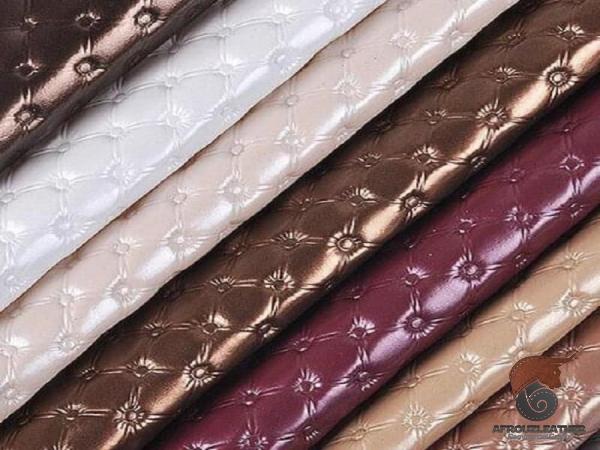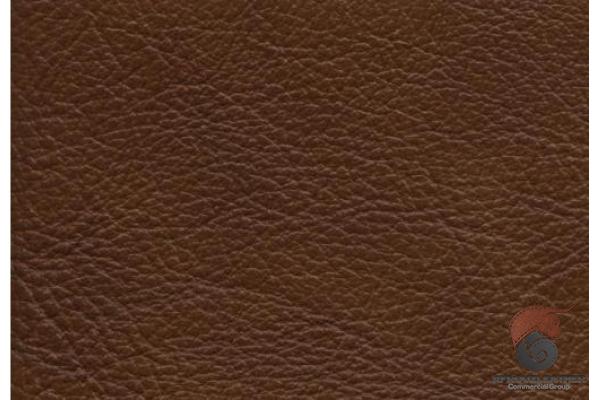The fashion and textile industry has witnessed a surge in the demand for exotic and luxurious materials, with ostrich leather being highly sought after. However, as the demand continues to rise, so does the prevalence of counterfeit products. Fake ostrich leather fabric has become a concerning issue within the industry, with many unsuspecting consumers being duped into purchasing imitation materials. In this article, we will explore the world of fake ostrich leather fabric, deciphering the differences between genuine and counterfeit products, and shedding light on the ethical implications associated with this flourishing market. 1. Understanding Ostrich Leather Fabric: Ostrich leather is derived from the hides of ostriches, making it a unique and highly desirable material due to its distinctive grain patterns and durability. Genuine ostrich leather involves a complex and meticulous tanning process to achieve the desired softness, pliability, and strength. It is a luxury material commonly used in the production of high-end fashion accessories such as handbags, shoes, wallets, and belts. 2. Identifying Fake Ostrich Leather Fabric: Counterfeit ostrich leather fabric attempts to mimic the appearance and texture of genuine ostrich leather, often at a fraction of the price.
leather
 However, there are key differences that can be identified to distinguish between the two. These include: a) Grain Pattern: Genuine ostrich leather features quill follicles, which are raised bumps resembling the pattern of small dots. Fake ostrich leather may have a printed pattern that mimics this, but upon close inspection, it lacks the depth and three-dimensional appearance of the genuine grain pattern. b) Imperfections and Consistency: Authentic ostrich leather often exhibits natural imperfections, such as scars and stretch marks, that add to its uniqueness. On the other hand, counterfeit products tend to have fewer or no imperfections, appearing more uniform and consistent. c) Texture and Feel: Genuine ostrich leather possesses a distinct texture that is soft, supple, and luxurious to the touch. Counterfeit materials may feel rigid and lack the pliability and natural grain of the real leather. d) Smell: Authentic ostrich leather typically carries a characteristic rich and earthy smell, while fake materials may have an artificial or chemical odor. 3. Ethical and Sustainability Concerns: The demand for ostrich leather has led to ethical concerns regarding the treatment of these exotic birds. Ostrich farming practices range from ethical to highly questionable, with some farms accused of subjecting the animals to inhumane conditions.
However, there are key differences that can be identified to distinguish between the two. These include: a) Grain Pattern: Genuine ostrich leather features quill follicles, which are raised bumps resembling the pattern of small dots. Fake ostrich leather may have a printed pattern that mimics this, but upon close inspection, it lacks the depth and three-dimensional appearance of the genuine grain pattern. b) Imperfections and Consistency: Authentic ostrich leather often exhibits natural imperfections, such as scars and stretch marks, that add to its uniqueness. On the other hand, counterfeit products tend to have fewer or no imperfections, appearing more uniform and consistent. c) Texture and Feel: Genuine ostrich leather possesses a distinct texture that is soft, supple, and luxurious to the touch. Counterfeit materials may feel rigid and lack the pliability and natural grain of the real leather. d) Smell: Authentic ostrich leather typically carries a characteristic rich and earthy smell, while fake materials may have an artificial or chemical odor. 3. Ethical and Sustainability Concerns: The demand for ostrich leather has led to ethical concerns regarding the treatment of these exotic birds. Ostrich farming practices range from ethical to highly questionable, with some farms accused of subjecting the animals to inhumane conditions.
Specifications of leather
 Consequently, consumers must be mindful of the source of their ostrich leather products and seek out companies that prioritize ethical sourcing and sustainable practices. 4. Consequences of Counterfeit Purchases: Purchasing fake ostrich leather fabric not only results in financial losses for consumers but also perpetuates an unethical market. Counterfeit products support illegal activities and unethical business practices, including child labor, poor working conditions, and the infringement of intellectual property rights. Moreover, as counterfeit products flood the market, genuine manufacturers and designers suffer from reputational damage and loss of sales. 5. Tips for Identifying Genuine Ostrich Leather Fabric: To avoid falling victim to counterfeit products, here are some useful tips to help identify genuine ostrich leather fabric: a) Research and Compare: Familiarize yourself with the appearance, texture, and grain patterns of genuine ostrich leather through research and study. Compare reputable and verified samples with suspected counterfeit products to spot any discrepancies. b) Price Analysis: Genuine ostrich leather fabric is a luxury material, and its pricing reflects this. If a product appears significantly cheaper than what is typically expected, exercise caution. c) Purchase from Reputable Retailers: Buy from trusted and authorized retailers, both online and offline. Reputable brands and stores are more likely to source and sell genuine materials.
Consequently, consumers must be mindful of the source of their ostrich leather products and seek out companies that prioritize ethical sourcing and sustainable practices. 4. Consequences of Counterfeit Purchases: Purchasing fake ostrich leather fabric not only results in financial losses for consumers but also perpetuates an unethical market. Counterfeit products support illegal activities and unethical business practices, including child labor, poor working conditions, and the infringement of intellectual property rights. Moreover, as counterfeit products flood the market, genuine manufacturers and designers suffer from reputational damage and loss of sales. 5. Tips for Identifying Genuine Ostrich Leather Fabric: To avoid falling victim to counterfeit products, here are some useful tips to help identify genuine ostrich leather fabric: a) Research and Compare: Familiarize yourself with the appearance, texture, and grain patterns of genuine ostrich leather through research and study. Compare reputable and verified samples with suspected counterfeit products to spot any discrepancies. b) Price Analysis: Genuine ostrich leather fabric is a luxury material, and its pricing reflects this. If a product appears significantly cheaper than what is typically expected, exercise caution. c) Purchase from Reputable Retailers: Buy from trusted and authorized retailers, both online and offline. Reputable brands and stores are more likely to source and sell genuine materials.
buy leather
 d) Seek Certifications: Look for certifications or labels that verify the authenticity and ethical sourcing of the product, such as the Convention on International Trade in Endangered Species of Wild Fauna and Flora (CITES) for legally harvested ostrich leather. 6. Legal Ramifications and Initiatives: The production and sale of counterfeit ostrich leather fabric is a violation of intellectual property rights, and legal actions can be taken against counterfeiters. In recent years, various organizations and luxury brands have been actively involved in the fight against counterfeiting. Intellectual Property Rights (IPR) enforcement has been strengthened, and international cooperation has been initiated to combat the production and distribution of counterfeit products. Conclusion: Fake ostrich leather fabric continues to pose a significant challenge in the fashion industry, affecting both consumers and genuine manufacturers. Understanding the differences between genuine and counterfeit materials and being vigilant when making purchases are the keys to mitigating the issue. Moreover, supporting the ethical and sustainable production of ostrich leather is vital to protect both the industry and the well-being of these majestic birds. By raising awareness and promoting responsible purchasing decisions, we can work towards a more transparent and counterfeit-free future.
d) Seek Certifications: Look for certifications or labels that verify the authenticity and ethical sourcing of the product, such as the Convention on International Trade in Endangered Species of Wild Fauna and Flora (CITES) for legally harvested ostrich leather. 6. Legal Ramifications and Initiatives: The production and sale of counterfeit ostrich leather fabric is a violation of intellectual property rights, and legal actions can be taken against counterfeiters. In recent years, various organizations and luxury brands have been actively involved in the fight against counterfeiting. Intellectual Property Rights (IPR) enforcement has been strengthened, and international cooperation has been initiated to combat the production and distribution of counterfeit products. Conclusion: Fake ostrich leather fabric continues to pose a significant challenge in the fashion industry, affecting both consumers and genuine manufacturers. Understanding the differences between genuine and counterfeit materials and being vigilant when making purchases are the keys to mitigating the issue. Moreover, supporting the ethical and sustainable production of ostrich leather is vital to protect both the industry and the well-being of these majestic birds. By raising awareness and promoting responsible purchasing decisions, we can work towards a more transparent and counterfeit-free future.

Your comment submitted.